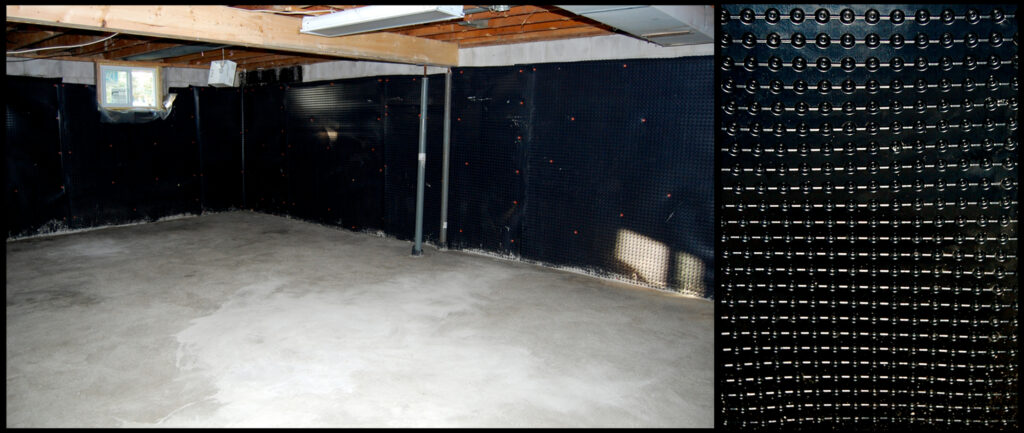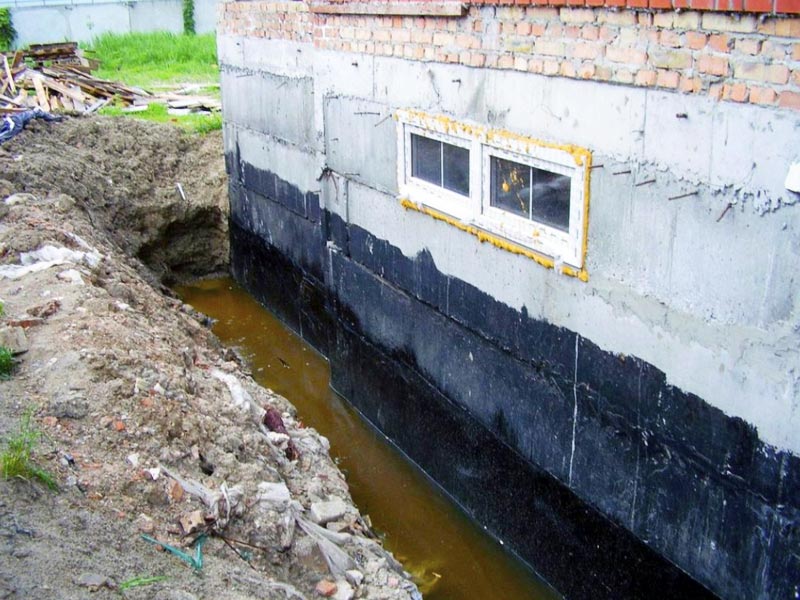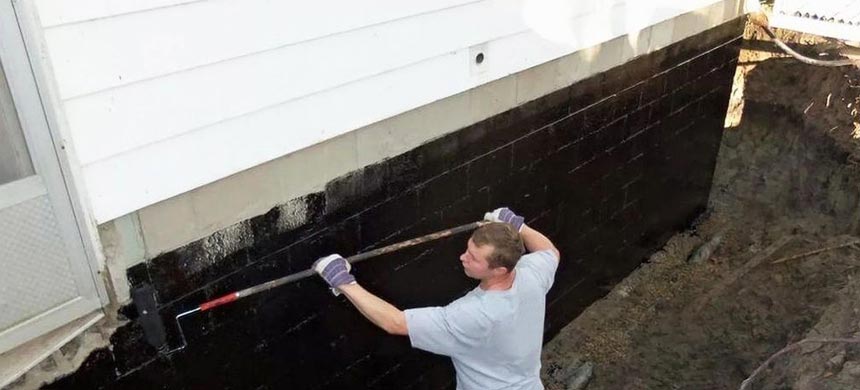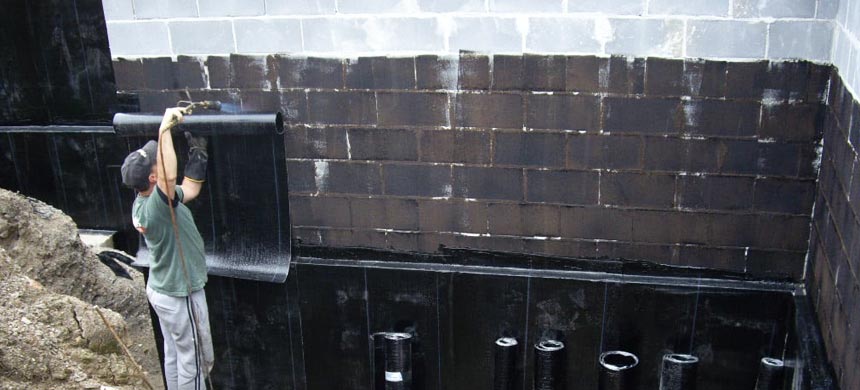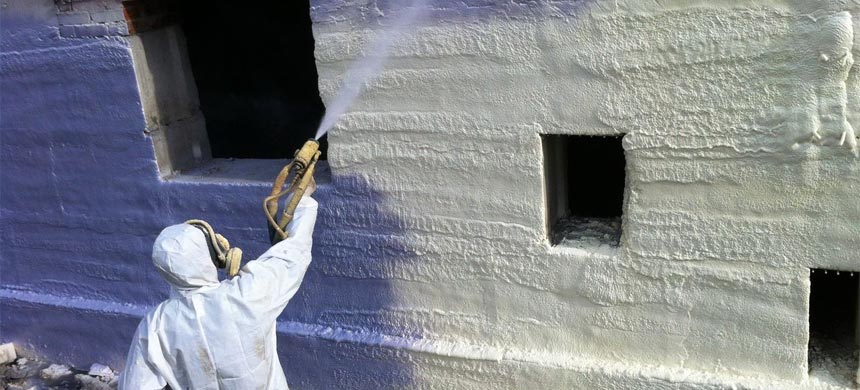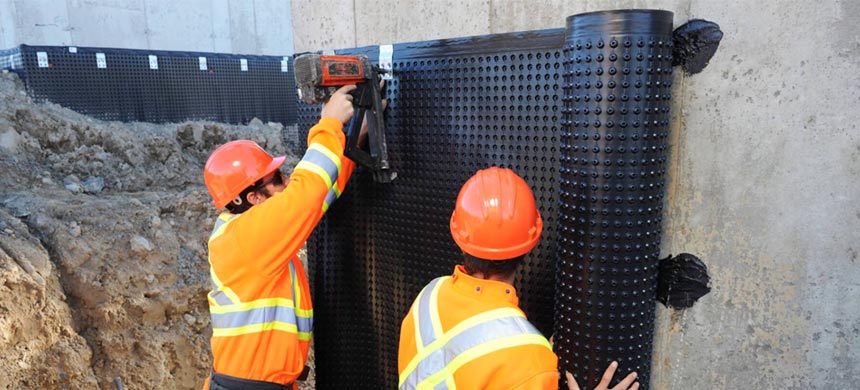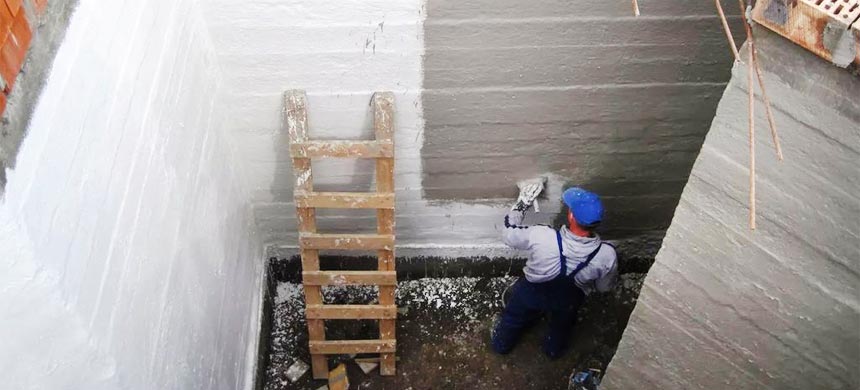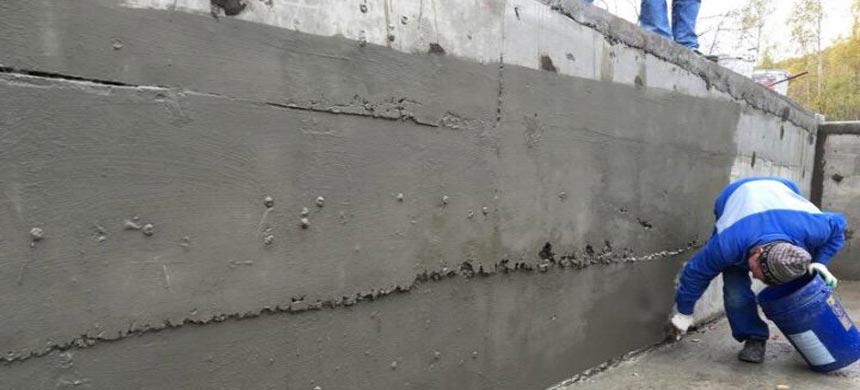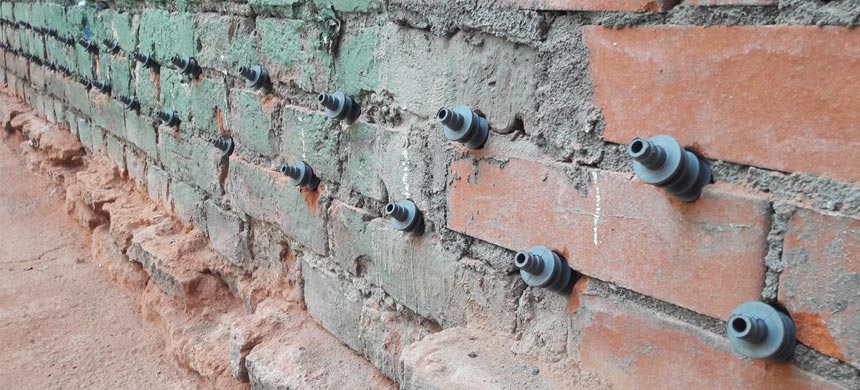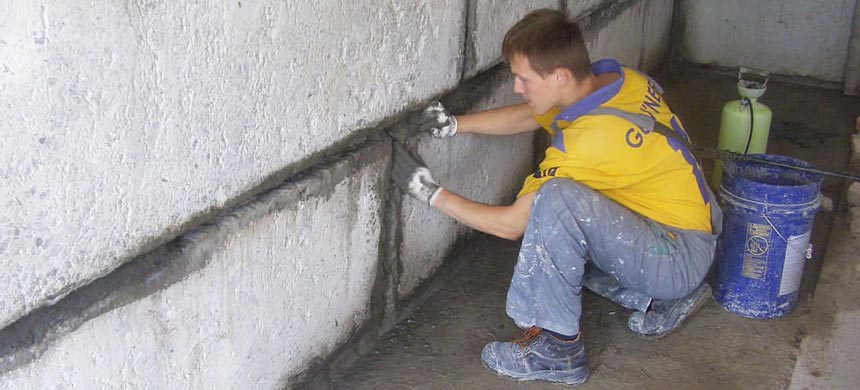Basement waterproofing from groundwater is its hydraulic protection using various technologies using various waterproof building materials, both outside and inside. The choice of method is determined mainly by the physical and technical characteristics of the basements, materials for their manufacture, and the hydrological state of the soil.
When is Basement Waterproofing Required?
Since the basement is called a room below ground level, it is more or less exposed to moisture. It can be surface stormwater or groundwater, the pools located on water-resistant clay layers and a certain distance underground.
Therefore, waterproofing the basement of a house is an obligatory stage of construction work and is always present during their implementation. Its use contributes to:
- Preservation and, accordingly, an increase in the service life of concrete walls, basement floors, their internal fittings.
- Reducing dampness in rooms causes corrosion of metals, destruction of interior items, and finishing coatings, contributing to the spread of fungus and mold.
- Improving the microclimate in the basements, lowering the humidity level, and preventing the air temperature from falling in cold weather.
Types of Basement Waterproofing From Groundwater
Differences in the types of waterproofing are determined by the technology of their application. On this basis, the following types of waterproofing in basements are distinguished.
Coating
This is a method of applying creamy waterproofing components using brushes, rollers, or spatulas.
According to this method, the basement is waterproofed from the outside from groundwater using bitumen-containing mastics protected from soil damage.
From the inside, waterproofing deep-penetrating compounds on cement and mastics on a polyurethane acrylic base are applied with a coating.
Usually, mastic waterproofing spreads on concrete surfaces with brushes in two mutually crossed layers.
Rolled
Embedded rolls on a bitumen, polymer-bitumen basis are usually used for waterproofing basements from the outside. Inside the technical premises, self-adhesive bitumen rolls are used on the floors.
Also, with the help of freely laid overlapping rolls, horizontal waterproofing is made before pouring the foundation slabs.
Another common application area for bitumen-containing rolls is a cut-off waterproofing device between the horizontal surface of a strip foundation (grillage) and walls made of any materials based on it.
Sprayed
According to the spraying technology, two-component liquid rubber and polyurethane mastics are applied to basements’ outer and inner walls.
This is not such a popular option for basement waterproofing due to the low technical performance of these materials if they are constantly in a moist state or under the mechanical influence of soils.
Membrane
For waterproofing basements from the outside, special PVC and polyolefin membranes are used. They are produced in canvases, the joints of which are soldered using a building hairdryer. Membrane waterproofing is fastened to vertical walls using clamping strips or dowels with self-tapping screws.
Planter-profiled membranes are widely used for waterproofing and protecting vertical walls underground. From above, the canvas is attached to planks or dowels, connecting on the sides by snapping several rows of profile cup-shaped protrusions.
Also, Planter profile membranes are often used in insulated slab foundations. They are placed on top of the extruded polystyrene foam insulation, then the reinforcing cage and formwork around the perimeter are mounted. After the reinforcement is poured with concrete, thus forming a waterproofed foundation slab.
Penetrating
The principle of operation of this type of waterproofing is their deep penetration into the porous structure of concrete. After that, the composition crystallizes and reliably closes all the smallest concrete pores.
Deep penetration waterproofing includes cement-based coating materials.
Especially for concrete, clogging impregnations are produced that fill its pores after crystallization. They are used both in finished structures and when pouring, adding to the concrete mixture.
Liquid glass, usually used indoors for waterproofing walls or floors, can be classified as a separate category of impregnations.
Another class of waterproofing impregnations is hydrophobic liquids that create a waterproof film on the concrete surface.
Plaster
The primary purpose of plaster is to level walls for high-quality installation of finishing coatings. Therefore, it is more often used in situations where waterproofing of a brick basement from the inside from groundwater is required or walls made of concrete blocks. To increase moisture protection, non-shrink blocks of cement, sealing, water-repellent materials, and elastic polymers are added to plaster compositions.
Plaster solutions are applied by the usual manual or machine method with a layer of no more than 25 mm. A printed metal mesh is used if a greater thickness or several plaster layers of waterproofing are required.
There is also a technology for applying plaster waterproofing by spraying special cement guns.
Injection
Waterproofing by injection with an injection under pressure into the structure of concrete, brickwork of liquid compositions is a modern high-tech method for solving complex problems. There are also non-pressure methods for supplying injection reagents to problem areas through glued packers (guide tubes), gravity into slots, or drilled holes.
First of all, injection waterproofing of the basement from the inside from groundwater is used to seal cracks in concrete, brick walls, floors, through which water enters the underground rooms.
With the help of injection, cut-off waterproofing is restored, the destruction of which leads to wetting and waterlogging of the walls.
Another area of application of injection waterproofing is the strengthening and creation of a layer of waterproof soil outside the basement walls.
Suture
One of the critical purposes of hydro protection is sealing seams’ communications inputs in concrete, brick, and other building structures.
In this case, elastic cement compositions or synthetic tapes are used for joint waterproofing. The latter can have a self-adhesive base, or elastic cement waterproofing is additionally used to fix them.
Entries around pipes or electrical cables are waterproofed with cement-based mixtures and some auxiliary materials (polyurethane sealants, foam rubber seals, cords that increase volume when wet).
Basement (Cellar) Waterproofing Materials
The abundance of materials used for external and internal waterproofing of basements and application technologies dramatically complicates the task of their correct selection for high-quality work. Therefore, it is more practical to entrust these operations to specialized firms with the necessary experience.
Rolls
Modern rolled waterproofing is made based on bitumen, bitumen polymers, and polymers.
Bitumens are artificial from petroleum products and oxidized (roofing) with a higher softening point.
To improve the physical characteristics of bitumen rolls, polymers are added to them: styrene – butadiene – styrene (SBS) or special polypropylene (APP) soluble in bitumen.
Also, rolls with a standard width of 1 m are produced with different bases made of cardboard (Roofing felt), fiberglass (Linocrom), fiberglass (Uniflex), and polyester fabric (Technoelast). For protection against physical, thermal influences, their coating for specific application areas is made of coarse and fine-grained powders, a protective polymer film, self-adhesive.
Before purchasing rolled waterproofing, it is helpful for the consumer to know that, depending on the cost, it is conditionally divided into 5 classes from the most expensive (Premium) to budget (Economy).
Mastics
The mastics presented on the construction market are conditionally divided into two main classes:
Polymer based on polyurethane (Hyperdesmo) or acrylic (Weber) basis. Polyurethane spraying technology is one-component and two-component, which usually treats surfaces of large areas.
Bituminous from:
- water emulsion of bitumen with mineral, chemical additives, and rubbers, mainly for interior decoration;
- on solvents with the addition of rubbers and minerals;
- hot from oxidized bitumen with minerals;
- polymer-bitumen in an aqueous solution of an emulsifier;
- latex-bitumen or so-called liquid (two-component sprayed for large areas) rubber.
Membranes
For waterproofing and protection of other moisture-proof materials, a profiled Planter membrane is attached to the outer vertical walls of the basements. The material is a high-density polyethylene (HPDE) sheet with 7.5 – 8 mm high molded round protrusions. The maximum length of Planter rolls is 20 m with a width of 1.2 or 3 m.
Also, for underground waterproofing, special PVC membranes made of extruded polyvinyl chloride (Ecobase V) are used, with low UV resistance. The length of this type of roll reaches 30 m, the width is 1 – 2.5 m.
Cement Mixtures
There are two primary varieties of dry cement waterborne waterproofing.
These are rigid deep penetration compounds (Ceresit, Dehydrol 5) and elastic with latex (Penecrit, Dehydrol 7). The first group of materials is used to protect large areas from moisture, and elastic compounds close up the input holes and seams and repair large cracks with their help.
Impregnation
Depending on the chemical composition, impregnation for concrete works in two main directions. Water repellents form a water-repellent film on the concrete surface and clog compounds (Kontacid 3, Dehydrol 10-2).
It should be noted that bridging impregnations can penetrate into the concrete structure at distances of up to 400 mm. In contrast, the maximum efficiency of the water-repellent properties of concrete is achieved at a bridging depth of 150 mm.
Impregnation materials can be directly introduced into the concrete before pouring or used for subsequent surface treatment.
Currently, silicate and organosilicate compositions are produced, the latter having the best efficiency. The main component of bridging impregnations is silicate liquid glass, independently performing these waterproofing functions.
Injectable Formulations
For injection into the concrete structure under high-pressure waterproofing mixtures, materials with high fluidity are used. The main types of injection formulations:
- acrylate two- and three-component gels;
- foaming and non-foaming silicate resins;
- micro cements in aqueous and polymeric solutions;
- epoxy two-component resins;
- one-component and two-component polyurethane resins.
Plasters
Traditional plaster waterproofing is the usual cement-sand composition for leveling walls with special additives. The latter are:
- seals made of ferric chloride, sodium aluminate, liquid cere site, bitumen;
- latex content by weight not more than 5%;
- liquid glass in an amount of not more than 2.5% by weight.
Special plaster mixtures for shotcrete (spraying) are based on colloidal cement mortars with finely ground fillers and traditional sand.
Protection of the Basement Floor from the Inside From Groundwater
Waterproofing contractors NYC for the basement floor from groundwater can be carried out at the stages of pouring the concrete foundation slab and (or) before laying the floor coverings.
In the first case, it is more efficient to carry it out using rolled materials or profiled membranes – Planters.
Given that groundwater has a higher head than capillary water, the floor inside basements should be protected with materials that have high adhesion (adhesion) to concrete. This is primarily cement-based deep penetration waterproofing impregnation.
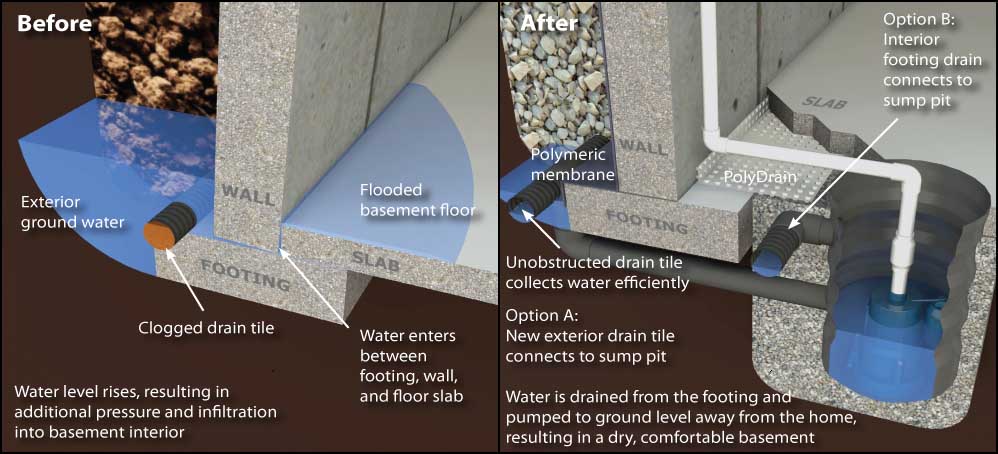
In complicated cases with high humidity below, it is possible to use bitumen-based roll materials (PVC membranes). They are glued to the floor with a direction on the walls or using bituminous mastics. Next, the rolls are covered with a screed with a reinforcing cage, subsequently coated with deep penetration cement waterproofing.
Basement Waterproofing Technology From Groundwater
The main problem faced when protecting basements from groundwater is their high pressure.
Therefore, waterproofing inside the basement from groundwater must have high adhesion to the concrete surface to not peel off from the walls under external pressure.
These conditions are best met by deep penetration cement compositions, which are applied using the following technology:
- The surface of the basement walls is cleaned of dust and dirt, while it is recommended to use high-pressure water jets.
- Wide cement joints on a concrete wall made of blocks are expanded, cleaned of dirt dust, and then filled with elastic repair waterproofing (Dehydrol 7). Before use, it is diluted with water to the consistency of plasticine.
- They do the same with wide slots and seams in the corners between the floor and walls. In their place, a rectangular or conical strobe about 25×25 mm in size is knocked out, and after cleaning it, the space is filled with elastic cement waterproofing.
- After the joints have dried, the surface of the walls is covered with contaminated water with a deep penetration cement-clogging waterproofing (Dehydrol 5). The material is applied with a brush in two mutually perpendicular layers.
- The treated surface of the inner walls of the basement is regularly moistened with water for one to three days. This allows the waterproofing to crystallize the pores in the concrete at a greater depth.
If the waterproofing of the basement from the inside from groundwater must have good adhesion with concrete, then for the outside, due to the direct pressure of water masses on the walls, this requirement is not so essential. Therefore, for external waterproofing of basement walls, a wide range of materials from bitumen rolls protected from damage by mastics, liquid rubber, membranes, and the same cement compositions can be used.
Common Mistakes
It is clear that if an ordinary consumer turns to specialists from specialized firms, for example, work for bluejaybuildersnyc, the likelihood of errors during waterproofing work will be reduced to zero. Troubles connected to waterlogging in basements are much more likely to occur if the owners trust their waterproofing to irresponsible builders or do it themselves.
Here are some examples of the most common mistakes made by non-specialists when doing waterproofing on their own:
- Priming of walls in case the penetrating waterproofing of the basement from the inside from groundwater is carried out. The bridging composition simply will not seep through the dried primer, which has clogged all the pores.
- Waterproof basement walls from the inside from groundwater without sealing joints between concrete blocks, floors, walls, and wide cracks according to the correct construction technology (channel chasing and puttying them with elastic waterproofing).
- Waterproofing a concrete basement from the inside from groundwater with deep penetration compounds without further wetting.
- The use of bitumen and polymer mastics on underground walls without protection (Planter, polystyrene foam insulation).
- Lack of priming of the walls with primers before laying the external rolled waterproofing or too high humidity of the concrete surface during the application of the compositions.
Conclusion
External and internal waterproofing of the basement from groundwater is carried out using different technologies using materials, the choice of which should correspond to the tasks being solved.
At the same time, to obtain high-quality and durable waterproofing, there is such a wide range of technical solutions that only specialists with significant experience can choose the best option. The most excellent chance to meet such employees is to contact a specialized company, Bluejaybuildersnyc.com.

